Conservation and Development: Reassessing the Florida 2070 Planning Project with Spatial Conservation Prioritization
Abstract
1. Introduction
2. Materials and Methods
2.1. Study Area
2.2. Framework of Reassessment Procedures
2.3. Zonation 4 Analysis for the Florida 2070 Project Scenarios
2.4. Assessing Florida 2070 Development Scenarios
3. Results
3.1. Landscape Prioritization with Zonation 4 Software
3.2. Zonation Performance Curve Result
3.3. Assessing Florida 2070 Projections
3.4. Close-Up Assessment and Analysis
4. Discussion
5. Conclusions
Author Contributions
Funding
Data Availability Statement
Acknowledgments
Conflicts of Interest
Appendix A
| Common Name | Scientific Name | Type | Global Rank * | State Rank ** |
| American Alligator | Alligator mississippiensis | Amphibian and reptile | G5 | S4 |
| American crocodile | Crocodylus acutus | Amphibian and reptile | G2 | S2 |
| American oystercatcher | Haematopus palliates | Bird | G5 | S2 |
| Atlantic salt marsh snake | Nerodia clarkii taeniata | Amphibian and reptile | T1 | S1 |
| Audubon’s crested caracara | Polyborus plancus audubonii | Bird | G5 | S2 |
| Bald eagle | Haliaeetus leucocephalus | Bird | G5 | S3 |
| Big Cypress fox squirrel | Sciurus niger avicennia | Mammal | T2 | S2 |
| Black rail | Laterallus jamaicensis | Bird | G3 | S2 |
| Black skimmer | Black skimmer | Bird | G5 | S3 |
| Black-whiskered vireo | Vireo altiloquus | Bird | G5 | S3 |
| Bluetail mole skink | Plestiodon egregius lividus | Amphibian and reptile | T2 | S2 |
| Cape Sable seaside sparrow | Ammodramus maritimus mirabilis | Bird | T1 | S1 |
| Cooper’s Hawk | Accipiter cooperii | Bird | G5 | S3 |
| Eastern diamondback rattlesnake | Crotalus adamanteus | Amphibian and reptile | G3 | S3 |
| Eastern indigo snake | Drymarchon couperi | Amphibian and reptile | G3 | S2 |
| Everglades mink | Neovison vison evergladensis | Mammal | G5 | S2 |
| Florida black bear | Ursus americanus floridanus | Mammal | T4 | S4 |
| Florida bonneted bat | Eumops floridanus | Mammal | G1 | S1 |
| Florida burrowing owl | Athene cunicularia | Bird | G4 | S3 |
| Florida grasshopper sparrow | Ammodramus savannarum floridanus | Bird | G5 | S1 |
| Florida Key deer | Odocoileus virginianus clavium | Mammal | T1 | S1 |
| Florida Keys mole skink | Plestiodon egregius egregius | Amphibian and reptile | T1 | S1 |
| Florida panther | Puma concolor coryi | Mammal | G5 | S1 |
| Florida sandhill crane | Antigone canadensis pratensis | Bird | G5 | S2 |
| Florida scrub lizard | Sceloporus woodi | Amphibian and reptile | G2 | S2 |
| Florida scrub-jay | Aphelocoma coerulescens | Bird | G2 | S2 |
| Gopher tortoise | Gopherus polyphemus | Amphibian and reptile | G3 | S3 |
| Key Largo woodrat | Neotoma floridana smalli | Mammal | T1 | S1 |
| Least tern | Sternula antillarum | Bird | G4 | S3 |
| Limpkin | Aramus guarauna | Bird | G5 | S3 |
| Little blue heron | Egretta caerulea | Bird | G5 | S4 |
| Lower Keys rabbit | Sylvilagus palustris hefneri | Mammal | T1 | S1 |
| Mangrove cuckoo | Coccyzus minor | Bird | G5 | S3 |
| Marsh rabbit | Sylvilagus palustris hefneri | Mammal | G5 | S5 |
| Mottled duck | Anas fulvigula | Bird | G4 | S3 |
| Ornate diamondback terrapin | Malaclemys terrapin macrospilota | Amphibian and reptile | T4 | N/A |
| Piping plover | Charadrius melodus | Bird | G3 | S2 |
| Red-cockaded woodpecker | Picoides borealis | Bird | G3 | S2 |
| Reddish egret | Egretta rufescens | Bird | G4 | S2 |
| Rice rat | Oryzomys palustris natator | Mammal | T2 | S2 |
| Rim rock crowned snake | Tantilla oolitica | Amphibian and reptile | G1 | S1 |
| roseate spoonbill | Platalea ajaja | Bird | G5 | S2 |
| Roseate tern | Sterna dougallii dougallii | Bird | T3 | S1 |
| Rufa red knot | Calidris canutus rufa | Bird | T2 | S2 |
| Sand skink | Plestiodon reynoldsi | Amphibian and reptile | G3 | S3 |
| Sherman’s fox squirrel | Sciurus niger shermani | Mammal | G5 | T3 |
| Short-tailed hawk | Buteo brachyurus | Bird | G4 | S1 |
| Snail kite | Rostrhamus sociabilis | Bird | G4 | S2 |
| Snowy egret | Egretta thula | Bird | G5 | S3 |
| Snowy plover | Charadrius nivosus | Bird | G3 | S1 |
| Southeastern American kestrel | Falco sparverius paulus | Bird | G5 | S3 |
| Southern chorus frog | Pseudacris nigrita | Amphibian and reptile | G5 | S5 |
| Striped mud turtle | Striped mud turtle | Amphibian and reptile | G5 | S5 |
| Swallow-tailed kite | Elanoides forficatus | Bird | G5 | S2 |
| Tricolored heron | Egretta tricolor | Bird | G5 | S4 |
| White crowned pigeon | Patagioenas leucocephala | Bird | G3 | S3 |
| white ibis | Eudocimus albus | Bird | G5 | S4 |
| Whooping crane | Grus americana | Bird | G1 | N/A |
| Wood stork | Mycteria Americana | Bird | G4 | S2 |
| Common Name | Weighting | Dispersal Capability | αValue in Zonation (α = 2/Dispersal Capability) |
| American Alligator | 2 | 15,000 | 0.000130 |
| American crocodile | 4 | 30,000 | 0.000067 |
| American oystercatcher | 4 | 5000 | 0.00040 |
| Atlantic salt marsh snake | 5 | 10,000 | 0.00020 |
| Audubon’s crested caracara | 4 | 20,000 | 0.00010 |
| Bald eagle | 3 | 10,000 | 0.00020 |
| Big Cypress fox squirrel | 4 | 5000 | 0.00040 |
| Black rail | 4 | 5000 | 0.00040 |
| Black skimmer | 3 | 5000 | 0.00040 |
| Black-whiskered vireo | 3 | 5000 | 0.00040 |
| Bluetail mole skink | 4 | 5000 | 0.00040 |
| Cape Sable seaside sparrow | 5 | 5000 | 0.00040 |
| Cooper’s Hawk | 3 | 10,000 | 0.00020 |
| Eastern diamondback rattlesnake | 3 | 5000 | 0.00040 |
| Eastern indigo snake | 4 | 10,000 | 0.00020 |
| Everglades mink | 4 | 790 | 0.00253 |
| Florida black bear | 2 | 150,000 | 0.0000133 |
| Florida bonneted bat | 5 | 5000 | 0.00040 |
| Florida burrowing owl | 3 | 5000 | 0.00040 |
| Florida grasshopper sparrow | 5 | 5000 | 0.00040 |
| Florida Key deer | 5 | 2600 | 0.00077 |
| Florida Keys mole skink | 5 | 5000 | 0.00040 |
| Florida panther | 5 | 29,000 | 0.000069 |
| Florida sandhill crane | 4 | 15,000 | 0.00013 |
| Florida scrub lizard | 4 | 5000 | 0.00040 |
| Florida scrub-jay | 4 | 3500 | 0.00057 |
| Gopher tortoise | 3 | 4000 | 0.00050 |
| Key Largo woodrat | 5 | 5000 | 0.00040 |
| Least tern | 3 | 5000 | 0.00040 |
| Limpkin | 3 | 5000 | 0.00040 |
| Little blue heron | 2 | 10,000 | 0.00020 |
| Lower Keys rabbit | 5 | 10,000 | 0.00020 |
| Mangrove cuckoo | 3 | 5000 | 0.00040 |
| Marsh rabbit | 1 | 10,000 | 0.00020 |
| Mottled duck | 3 | 10,000 | 0.00020 |
| Ornate diamondback terrapin | 1 | 10,000 | 0.00020 |
| Piping plover | 4 | 5000 | 0.00040 |
| Red-cockaded woodpecker | 4 | 8000 | 0.00025 |
| Reddish egret | 4 | 10,000 | 0.00020 |
| Rice rat | 4 | 5000 | 0.00040 |
| Rim rock crowned snake | 5 | 5000 | 0.00040 |
| roseate spoonbill | 4 | 10,000 | 0.00020 |
| Roseate tern | 5 | 5000 | 0.00040 |
| Rufa red knot | 4 | 5000 | 0.00040 |
| Sand skink | 3 | 5000 | 0.00040 |
| Sherman’s fox squirrel | 3 | 740 | 0.00270 |
| Short-tailed hawk | 5 | 10,000 | 0.00020 |
| Snail kite | 4 | 10,000 | 0.00020 |
| Snowy egret | 3 | 10,000 | 0.00020 |
| Snowy plover | 5 | 1000 | 0.00200 |
| Southeastern American kestrel | 3 | 10,000 | 0.00020 |
| Southern chorus frog | 1 | 5000 | 0.00040 |
| Striped mud turtle | 1 | 10,000 | 0.00020 |
| Swallow-tailed kite | 4 | 10,000 | 0.00020 |
| Tricolored heron | 2 | 10,000 | 0.00020 |
| White crowned pigeon | 3 | 10,000 | 0.00020 |
| white ibis | 2 | 10,000 | 0.00020 |
| Whooping crane | 5 | 5000 | 0.00040 |
| Wood stork | 4 | 10,000 | 0.00020 |
References
- Ahern, J. Urban landscape sustainability and resilience: The promise and challenges of integrating ecology with urban planning and design. Landsc. Ecol. 2013, 28, 1203–1212. [Google Scholar] [CrossRef]
- Lu, Y.; Bullock, J.M. Biodiversity conservation in a changing environment beyond 2020. Sci. Adv. 2021, 7, eabl8162. [Google Scholar] [CrossRef]
- Newbold, T.; Hudson, L.N.; Hill, S.L.L.; Contu, S.; Lysenko, I.; Senior, R.A.; Börger, L.; Bennett, D.J.; Choimes, A.; Collen, B.; et al. Global effects of land use on local terrestrial biodiversity. Nature 2015, 520, 45–50. [Google Scholar] [CrossRef] [PubMed]
- Yang, R.; Cao, Y.; Hou, S.; Peng, Q.; Wang, X.; Wang, F.; Tseng, T.-H.; Yu, L.; Carver, S.; Convery, I.; et al. Cost-effective priorities for the expansion of global terrestrial protected areas: Setting post-2020 global and national targets. Sci. Adv. 2020, 6, eabc3436. [Google Scholar] [CrossRef]
- König, H.J.; Kiffner, C.; Kramer-Schadt, S.; Fürst, C.; Keuling, O.; Ford, A.T. Human–wildlife coexistence in a changing world. Conserv. Biol. 2020, 34, 786–794. [Google Scholar] [CrossRef] [PubMed]
- Pooley, S.; Bhatia, S.; Vasava, A. Rethinking the study of human–wildlife coexistence. Conserv. Biol. 2021, 35, 784–793. [Google Scholar] [CrossRef]
- Redpath, S.M.; Young, J.; Evely, A.; Adams, W.M.; Sutherland, W.J.; Whitehouse, A.; Amar, A.; Lambert, R.A.; Linnell, J.D.C.; Watt, A.; et al. Understanding and managing conservation conflicts. Trends Ecol. Evol. 2013, 28, 100–109. [Google Scholar] [CrossRef]
- Karimi, A.; Tulloch, A.I.T.; Brown, G.; Hockings, M. Understanding the effects of different social data on selecting priority conservation areas. Conserv. Biol. 2017, 31, 1439–1449. [Google Scholar] [CrossRef] [PubMed]
- Young, J.C.; Marzano, M.; White, R.M.; McCracken, D.I.; Redpath, S.M.; Carss, D.N.; Quine, C.P.; Watt, A.D. The emergence of biodiversity conflicts from biodiversity impacts: Characteristics and management strategies. Biodivers. Conserv. 2010, 19, 3973–3990. [Google Scholar] [CrossRef]
- Henle, K.; Alard, D.; Clitherow, J.; Cobb, P.; Firbank, L.; Kull, T.; McCracken, D.; Moritz, R.F.A.; Niemelä, J.; Rebane, M.; et al. Identifying and managing the conflicts between agriculture and biodiversity conservation in Europe—A review. Agric. Ecosyst. Environ. 2008, 124, 60–71. [Google Scholar] [CrossRef]
- Moilanen, A.; Wilson, K.; Possingham, H. Spatial Conservation Prioritization: Quantitative Methods and Computational Tools; Oxford University Press: Oxford, UK, 2009. [Google Scholar]
- Peng, Q.; Yang, R. A Review of Conservation Conflict Research: Concepts, Research Progress and Governance Strategies. Landsc. Archit. 2021, 28, 53–57. [Google Scholar] [CrossRef]
- Jalkanen, J.; Toivonen, T.; Moilanen, A. Identification of ecological networks for land-use planning with spatial conservation prioritization. Landsc. Ecol. 2020, 35, 353–371. [Google Scholar] [CrossRef]
- Jalkanen, J.; Vierikko, K.; Moilanen, A. Spatial prioritization for urban Biodiversity Quality using biotope maps and expert opinion. Urban For. Urban Green. 2020, 49, 126586. [Google Scholar] [CrossRef]
- Kreitler, J.; Schloss, C.A.; Soong, O.; Hannah, L.; Davis, F.W. Conservation planning for offsetting the impacts of development: A case study of biodiversity and renewable energy in the Mojave Desert. PLoS ONE 2015, 10, e0140226. [Google Scholar] [CrossRef] [PubMed]
- Moilanen, A. Planning impact avoidance and biodiversity offsetting using software for spatial conservation prioritisation. Wildl. Res. 2013, 40, 153–162. [Google Scholar] [CrossRef]
- Gordon, A.; Simondson, D.; White, M.; Moilanen, A.; Bekessy, S.A. Integrating conservation planning and landuse planning in urban landscapes. Landsc. Urban Plan. 2009, 91, 183–194. [Google Scholar] [CrossRef]
- Moilanen, A.; Franco, A.M.A.; Early, R.I.; Fox, R.; Wintle, B.; Thomas, C.D. Prioritizing multiple-use landscapes for conservation: Methods for large multi-species planning problems. Proc. R. Soc. B Biol. Sci. 2005, 272, 1885–1891. [Google Scholar] [CrossRef]
- Zhu, M.J.; Hoctor, T.S.; Volk, M.; Frank, K.I.; Zwick, P.D.; Carr, M.H.; Linhoss, A.C. Spatial conservation prioritization to conserve biodiversity in response to sea level rise and land use change in the Matanzas River Basin, Northeast Florida. Landsc. Urban Plan. 2015, 144, 103–118. [Google Scholar] [CrossRef]
- Bekessy, S.A.; White, M.; Gordon, A.; Moilanen, A.; Mccarthy, M.A.; Wintle, B.A. Transparent planning for biodiversity and development in the urban fringe. Landsc. Urban Plan. 2012, 108, 140–149. [Google Scholar] [CrossRef]
- Lehtomäki, J.; Tomppo, E.; Kuokkanen, P.; Hanski, I.; Moilanen, A. Applying spatial conservation prioritization software and high-resolution GIS data to a national-scale study in forest conservation. For. Ecol. Manag. 2009, 258, 2439–2449. [Google Scholar] [CrossRef]
- Baynham-Herd, Z.; Redpath, S.; Bunnefeld, N.; Molony, T.; Keane, A. Conservation conflicts: Behavioural threats, frames, and intervention recommendations. Biol. Conserv. 2018, 222, 180–188. [Google Scholar] [CrossRef]
- Pickett, S.T.A.; Cadenasso, M.L.; Childers, D.L.; Mcdonnell, M.J.; Zhou, W. Evolution and future of urban ecological science: Ecology in, of, and for the city. Ecosyst. Health Sustain. 2016, 2, e01229. [Google Scholar] [CrossRef]
- Karimi, A.; Hockings, M. A social-ecological approach to land-use conflict to inform regional and conservation planning and management. Landsc. Ecol. 2018, 33, 691–710. [Google Scholar] [CrossRef]
- Whitehead, A.L.; Kujala, H.; Ives, C.D.; Gordon, A.; Lentini, P.E.; Wintle, B.A.; Nicholson, E.; Raymond, C.M. Integrating biological and social values when prioritizing places for biodiversity conservation. Conserv. Biol. 2014, 28, 992–1003. [Google Scholar] [CrossRef]
- Chen, F.; Zhu, M.; Yuan, L. Urban Planning in Response to Sea Level Rise and Future Urbanization in Southern Florida. In Proceedings of the 2022 6th International Conference on Green Energy and Applications (ICGEA), Singapore, 4–6 March 2022; pp. 240–244. [Google Scholar] [CrossRef]
- Stys, B.; Foster, T.; Fuentes, M.M.P.B.; Glazer, B.; Karish, K.; Montero, N.; Reece, J.S. Climate Change Impacts on Florida’s Biodiversity and Ecology. In Florida’s Climate: Changes, Variations, & Impacts; Florida Climate Institute: Gainesville, FL, USA, 2017; Chapter 12; pp. 339–389. [Google Scholar] [CrossRef]
- Blaustein, R.J. Biodiversity hotspot: The Florida panhandle. BioScience 2008, 58, 784–790. [Google Scholar] [CrossRef]
- Gainsbury, A.M.; Santos, E.G.; Wiederhecker, H. Does urbanization impact terrestrial vertebrate ectotherms across a biodiversity hotspot? Sci. Total Environ. 2022, 835, 155446. [Google Scholar] [CrossRef]
- Volk, M.; Hoctor, T.; Nettles, B.; Hilsenbeck, R.; Putz, F.; Oetting, J. Florida Land Use and Land Cover Change in the Past 100 Years. In Florida’s Climate: Changes, Variations, & Impacts; Florida Climate Institute: Gainesville, FL, USA, 2017; Chapter 2; pp. 51–82. [Google Scholar] [CrossRef][Green Version]
- Florida Department of Agriculture and Consumer Services; University of Florida Geoplan Center; 1000 Friends of Florida. Florida 2070 Summary Report. 2016. Available online: https://1000friendsofflorida.org/florida2070/table-of-contents (accessed on 25 November 2022).
- Florida Department of Transportation. Projections of Florida Population by County, 2020–2070 Prepared for Forecasting and Trends Office; Florida Department of Transportation: Tallahassee, FL, USA, 2020.
- Haaland, C.; van den Bosch, C.K. Challenges and strategies for urban green-space planning in cities undergoing densification: A review. Urban For. Urban Green. 2015, 14, 760–771. [Google Scholar] [CrossRef]
- Carr, M.H.; Zwick, P.D. Technical Report Florida 2070: Mapping Florida’s Future–Alternative Patterns of Development in 2070. A research project prepared by the Geoplan Center at the University of Florida for the Florida Department of Agriculture and Consumer Services & 1000 Friends of Florida. 2016. Available online: https://1000friendsofflorida.org/florida2070/wp-content/uploads/2016/09/florida2070technicalreportfinal.pdf (accessed on 25 November 2022).
- Kareksela, S.; Moilanen, A.; Tuominen, S.; Kotiaho, J.S. Use of Inverse Spatial Conservation Prioritization to Avoid Biological Diversity Loss Outside Protected Areas. Conserv. Biol. 2013, 27, 1294–1303. [Google Scholar] [CrossRef]
- Poor, E.E.; Scheick, B.K.; Mullinax, J.M. Multiscale consensus habitat modeling for landscape level conservation prioritization. Sci. Rep. 2020, 10, 17783. [Google Scholar] [CrossRef]
- Brown, M.T.; Cohen, M.J.; Bardi, E.; Ingwersen, W.W. Species diversity in the Florida Everglades, USA: A systems approach to calculating biodiversity. Aquat. Sci. 2006, 68, 254–277. [Google Scholar] [CrossRef]
- U.S. Fish and Wildlife Service. South Florida Multi-Species Recovery Plan; U.S. Fish and Wildlife Service: Washington, DC, USA, 1999.
- Kremen, C.; Cameron, A.; Moilanen, A.; Phillips, S.J.; Thomas, C.D.; Beentje, H.; Dransfield, J.; Fisher, B.L.; Glaw, F.; Good, T.C.; et al. Aligning conservation priorities across taxa in Madagascar with high-resolution planning tools. Science 2008, 320, 222–226. [Google Scholar] [CrossRef] [PubMed]
- National Wildlife Refuge Association; University of Florida Center for Landscape Conservation Planning. Southwest Florida Landscape Conservation Design; National Wildlife Refuge Association: Washington, DC, USA; University of Florida Center for Landscape Conservation Planning: Gainesville, FL, USA, 2017. [Google Scholar]
- Bureau of Economic and Business Research; College of Liberal Arts and Sciences, University of Florida. Florida Population: Census Summary 2020; Bureau of Economic and Business Research; University of Florida: Gainesville, FL, USA, 2021. [Google Scholar]
- Bureau of Economic and Business Research; College of Liberal Arts and Sciences, University of Florida. Florida Estimates of Population 2021; Bureau of Economic and Business Research; University of Florida: Gainesville, FL, USA, 2022. [Google Scholar]
- Moilanen, A.; Pouzols, F.M.; Meller, L.; Veach, V.; Arponen, A.; Leppanen, J.; Kujala, H. Zonation—User Manual. 2004. Available online: https://www.syke.fi/en-US/Research__Development/Nature/Specialist_work/Zonation_in_Finland/Zonation_software (accessed on 25 November 2022).
- Cristaldi, M.A.; Sarquis, J.A.; Arzamendia, V.; Bellini, G.P.; Giraudo, A.R. Human activity and climate change as determinants of spatial prioritization for the conservation of globally threatened birds in the southern Neotropic (Santa Fe, Argentina). Biodivers. Conserv. 2019, 28, 2531–2553. [Google Scholar] [CrossRef]
- Endries, M.; Stys, B.; Mohr, G.; Kratimenos, G.; Langley, S.; Root, K.; Kautz, R. Wildlife Habitat Conservation Needs in Florida Updated Recommendations for Strategic Habitat Conservation Areas; Fish and Wildlife Research Institute: St. Petersburg, FL, USA, 2009. [Google Scholar]
- Rule: 68A-27.003 Florida Endangered and Threatened Species List; Prohibitions. Available online: https://www.flrules.org/gateway/RuleNo.asp?title=RULES%20RELATING%20TO%20ENDANGERED%20OR%20THREATENED%20SPECIES&ID=68A-27.003 (accessed on 15 November 2022).
- Lehtomäki, J.; Moilanen, A. Methods and workflow for spatial conservation prioritization using Zonation. Environ. Model. Softw. 2013, 47, 128–137. [Google Scholar] [CrossRef]
- Rodgers, P.D.; Pienaar, E.F. Tolerance for the Florida panther in exurban southwest Florida. J. Wildl. Manag. 2018, 82, 865–876. [Google Scholar] [CrossRef]
- Moilanen, A.; Runge, M.C.; Elith, J.; Tyre, A.; Carmel, Y.; Fegraus, E.; Wintle, B.A.; Burgman, M.; Ben-Haim, Y. Planning for robust reserve networks using uncertainty analysis. Ecol. Model. 2006, 199, 115–124. [Google Scholar] [CrossRef]
- Rae, C.; Rothley, K.; Dragicevic, S. Implications of error and uncertainty for an environmental planning scenario: A sensitivity analysis of GIS-based variables in a reserve design exercise. Landsc. Urban Plan. 2007, 79, 210–217. [Google Scholar] [CrossRef]
- Kujala, H.; Whitehead, A.L.; Morris, W.K.; Wintle, B.A. Towards strategic offsetting of biodiversity loss using spatial prioritization concepts and tools: A case study on mining impacts in Australia. Biol. Conserv. 2015, 192, 513–521. [Google Scholar] [CrossRef]
- Moilanen, A.; Wintle, B.A. Uncertainty analysis favours selection of spatially aggregated reserve networks. Biol. Conserv. 2006, 129, 427–434. [Google Scholar] [CrossRef]
- Lewis, J.S.; Rachlow, J.L.; Garton, E.O.; Vierling, L.A. Effects of habitat on GPS collar performance: Using data screening to reduce location error. J. Appl. Ecol. 2007, 44, 663–671. [Google Scholar] [CrossRef]
- Pellerin, M.; Said, S.; Gaillard, J.M. Roe deer Capreolus capreolus home-range sizes estimated from VHF and GPS data. Wildl. Biol. 2008, 14, 101–110. [Google Scholar] [CrossRef]
- Fallding, M. Planning for biodiversity: Can we do it better? Aust. Plan. 2004, 41, 45–50. [Google Scholar] [CrossRef]
- Wintle, B.A.; Kujala, H.; Whitehead, A.; Cameron, A.; Veloz, S.; Kukkala, A.; Moilanen, A.; Gordon, A.; Lentini, P.E.; Cadenhead, N.C.R.; et al. Global synthesis of conservation studies reveals the importance of small habitat patches for biodiversity. Proc. Natl. Acad. Sci. USA 2019, 116, 909–914. [Google Scholar] [CrossRef] [PubMed]
- Davis, A.G.; Cox, J.J.; Fei, S. Alternative 2070: Mitigating the effects of projected sea level rise and urbanization on Florida black bear and Florida panther habitat. J. Nat. Conserv. 2021, 63, 126052. [Google Scholar] [CrossRef]
- Travis, J.M.J. Climate change and habitat destruction: A deadly anthropogenic cocktail. Proc. R. Soc. B Biol. Sci. 2003, 270, 467–473. [Google Scholar] [CrossRef] [PubMed]
- With, K.A.; King, A.W. Extinction Thresholds for Species in Fractal Landscapes. Conserv. Biol. 1999, 13, 314–326. [Google Scholar] [CrossRef]
- Lindholst, A.C.; Caspersen, O.H.; Konijnendijk Van Den Bosch, C.C. Methods for mapping recreational and social values in urban green spaces in the nordic countries and their comparative merits for urban planning. J. Outdoor Recreat. Tour. 2015, 12, 71–81. [Google Scholar] [CrossRef]
- Grahn, P.; Stigsdotter, U.K. The relation between perceived sensory dimensions of urban green space and stress restoration. Landsc. Urban Plan. 2010, 94, 264–275. [Google Scholar] [CrossRef]
- Naidoo, R.; Balmford, A.; Ferraro, P.J.; Polasky, S.; Ricketts, T.H.; Rouget, M. Integrating economic costs into conservation planning. Trends Ecol. Evol. 2006, 21, 681–687. [Google Scholar] [CrossRef]
- Lindholst, A.C.; Dempsey, N.; Burton, M. Introducing a method for mapping recreational experience. Proc. Inst. Civ. Eng. Urban Des. Plan. 2013, 166, 296–308. [Google Scholar] [CrossRef]
- Ståhle, A. Sociotope Mapping-Exploring Public Open Space and Its Multiple Use Values in Urban and Landscape Planning Practice. 2016. Available online: https://www.researchgate.net/publication/281228875 (accessed on 25 November 2022).
- Fu, W.; Ding, Q.; Sun, Z.; Xu, T. Spatial conservation prioritization considering socioeconomic costs and degradation conditions in the Southwest China Biodiversity Hotspot. Environ. Conserv. 2021, 48, 143–150. [Google Scholar] [CrossRef]
- Kujala, H.; Lahoz-Monfort, J.J.; Elith, J.; Moilanen, A. Not all data are equal: Influence of data type and amount in spatial conservation prioritisation. Methods Ecol. Evol. 2018, 9, 2249–2261. [Google Scholar] [CrossRef]
- Moilanen, A.; Anderson, B.J.; Eigenbrod, F.; Heinemeyer, A.; Roy, D.B.; Gillings, S.; Armsworth, P.R.; Gaston, K.J.; Thomas, C.D. Balancing alternative land uses in conservation prioritization. Ecol. Appl. 2011, 21, 1419–1426. [Google Scholar] [CrossRef] [PubMed]
- Shackelford, G.E.; Steward, P.R.; German, R.N.; Sait, S.M.; Benton, T.G. Conservation planning in agricultural landscapes: Hotspots of conflict between agriculture and nature. Divers. Distrib. 2015, 21, 357–367. [Google Scholar] [CrossRef] [PubMed]
- McIntosh, E.J.; Chapman, S.; Kearney, S.G.; Williams, B.; Althor, G.; Thorn, J.P.R.; Pressey, R.L.; McKinnon, M.C.; Grenyer, R. Absence of evidence for the conservation outcomes of systematic conservation planning around the globe: A systematic map. Environ. Evid. 2018, 7, 22. [Google Scholar] [CrossRef]
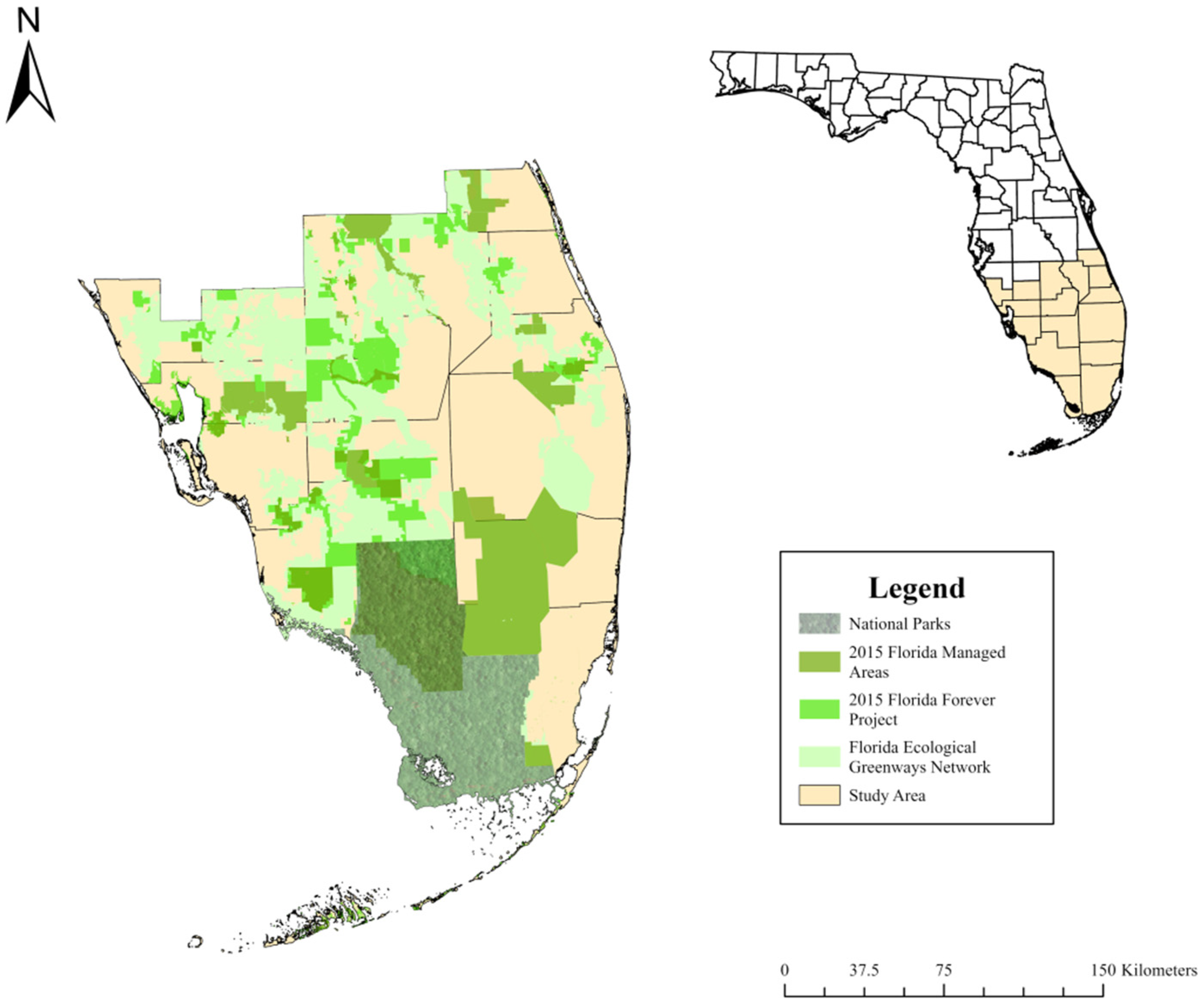
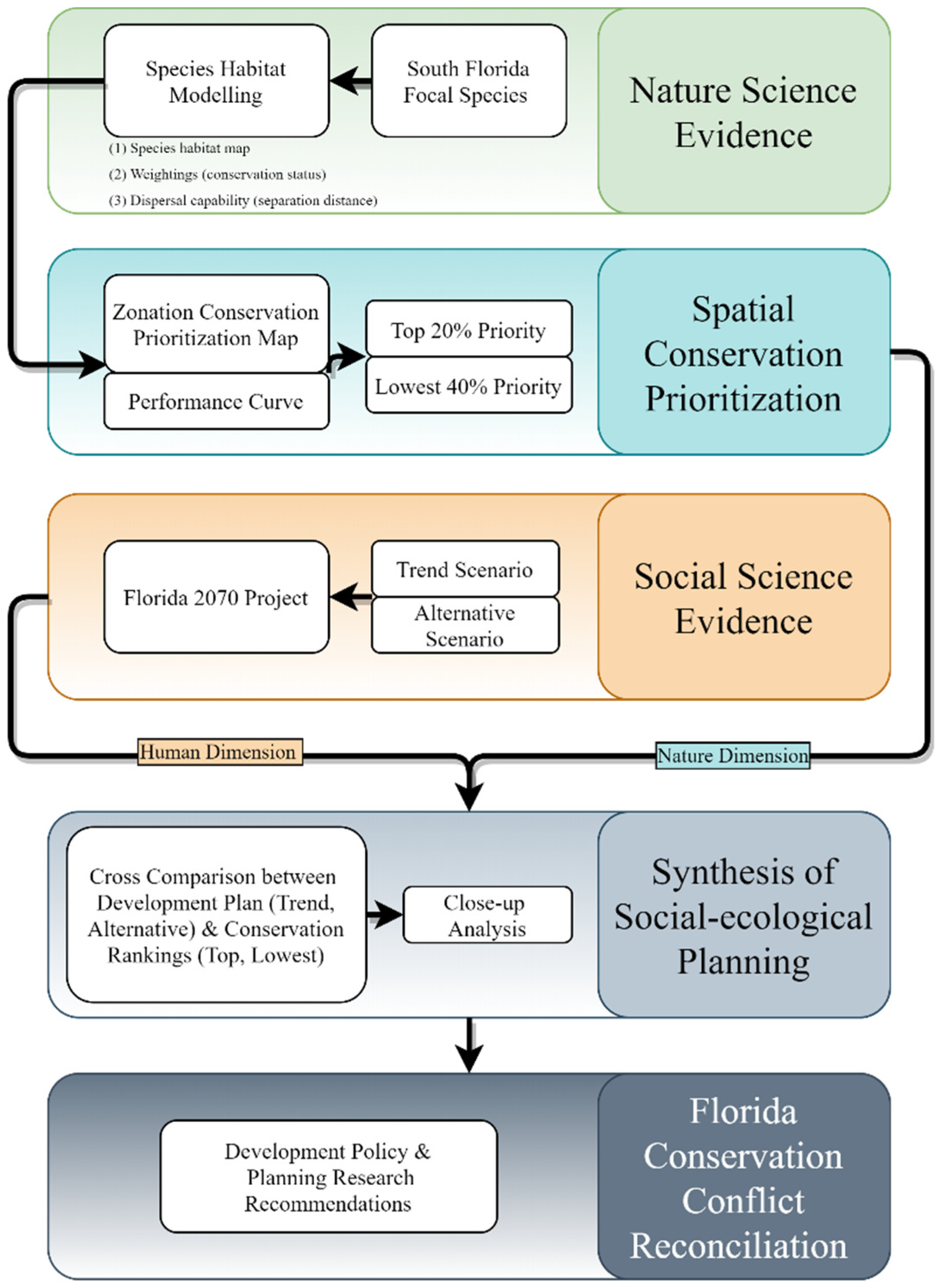
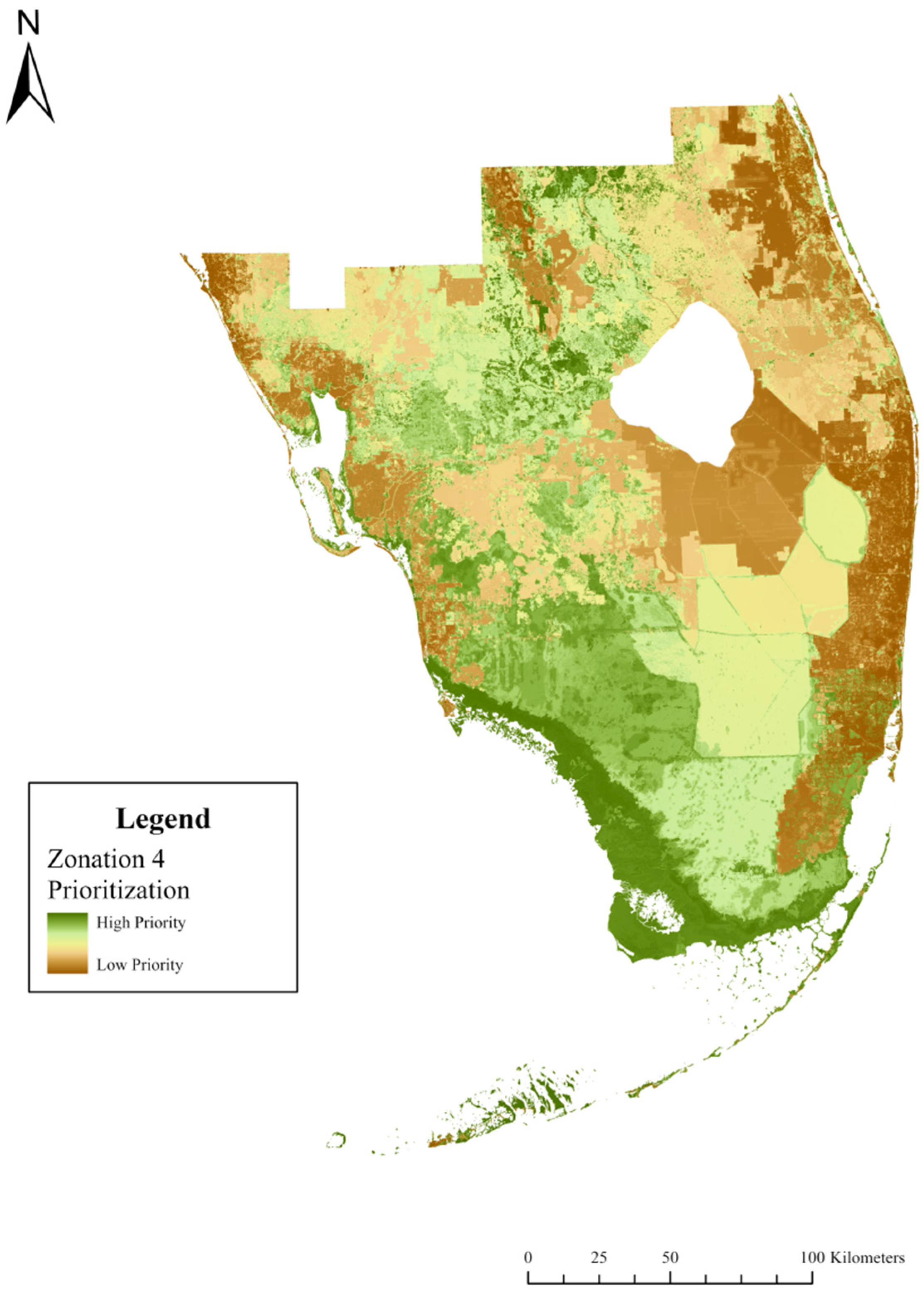
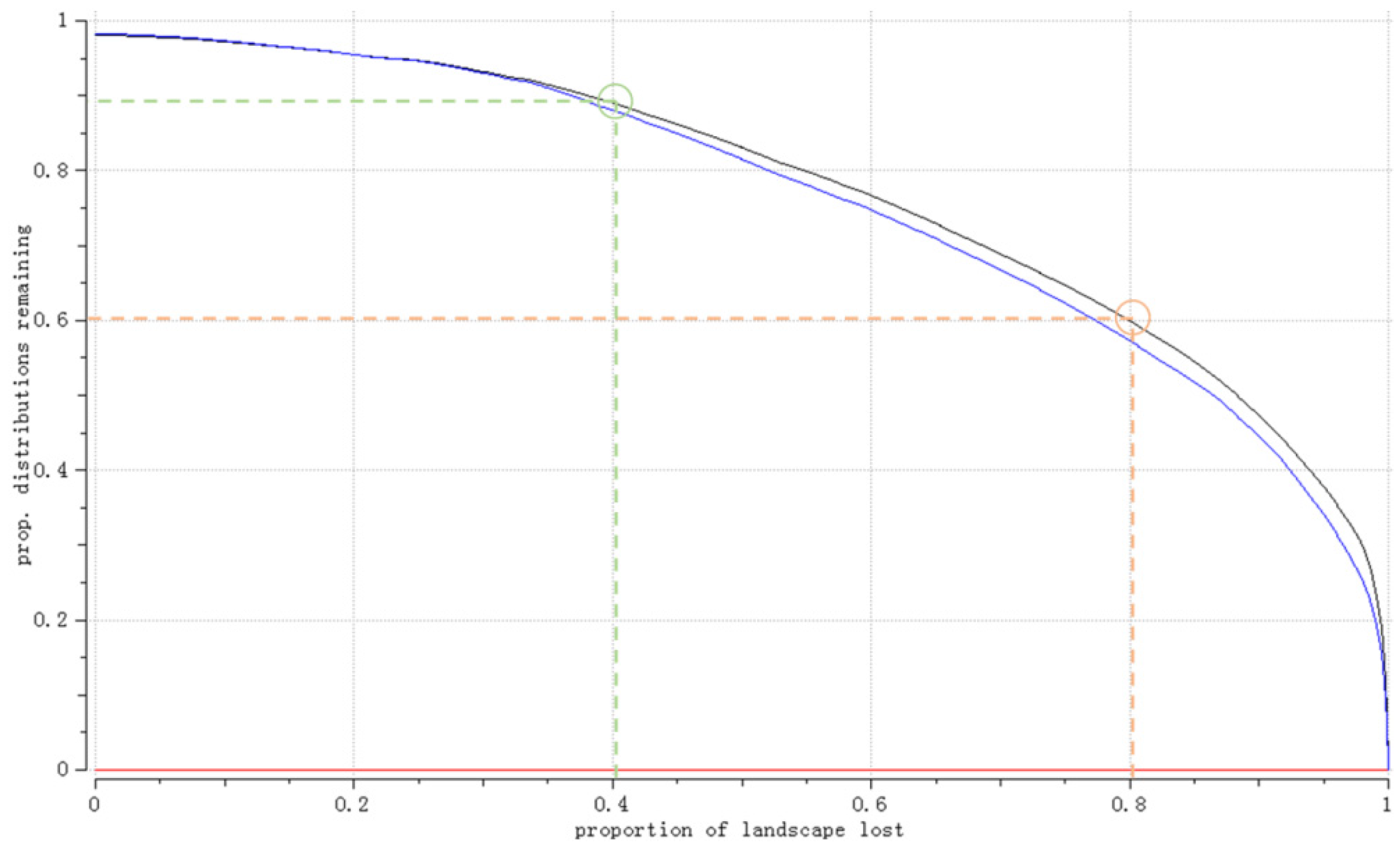
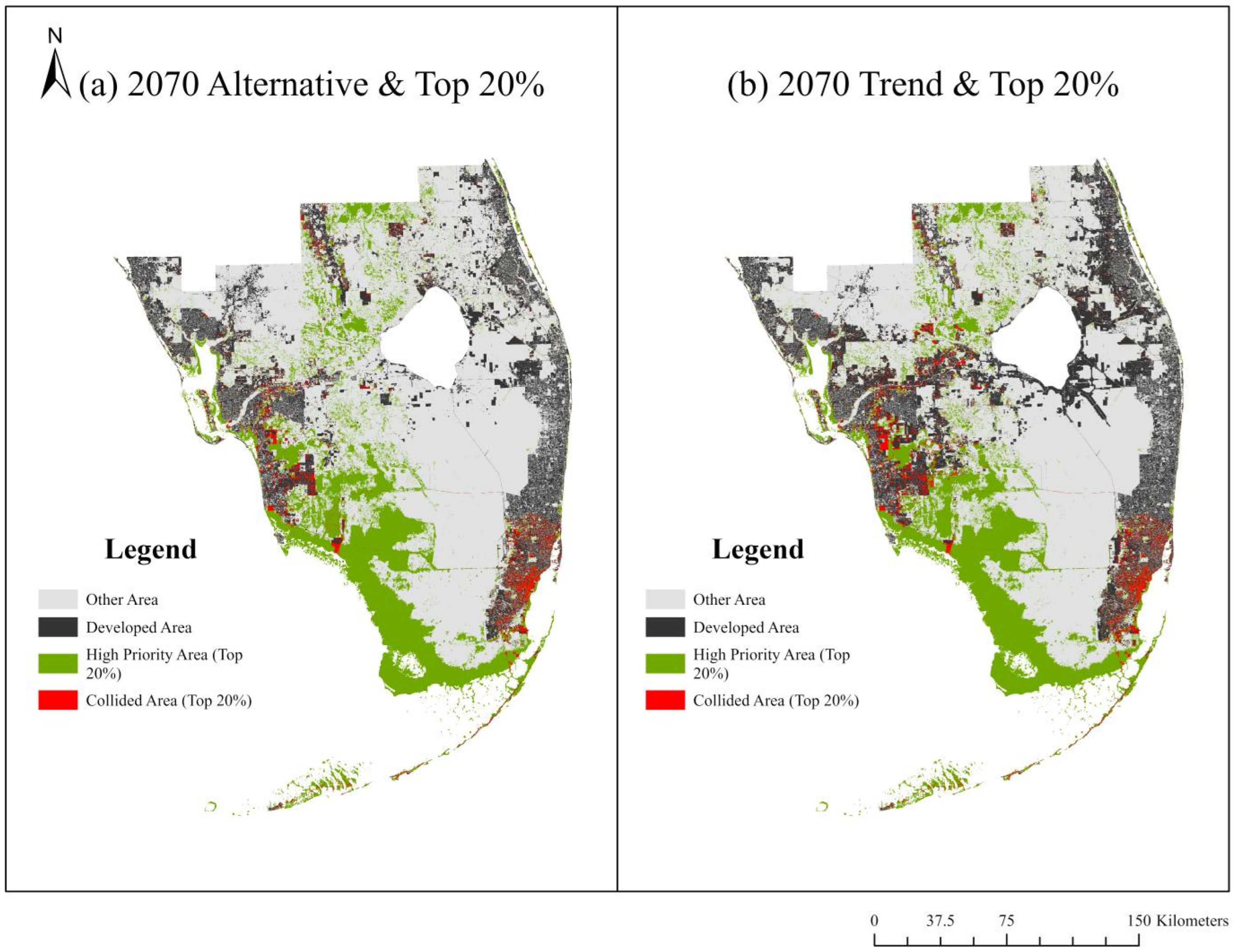
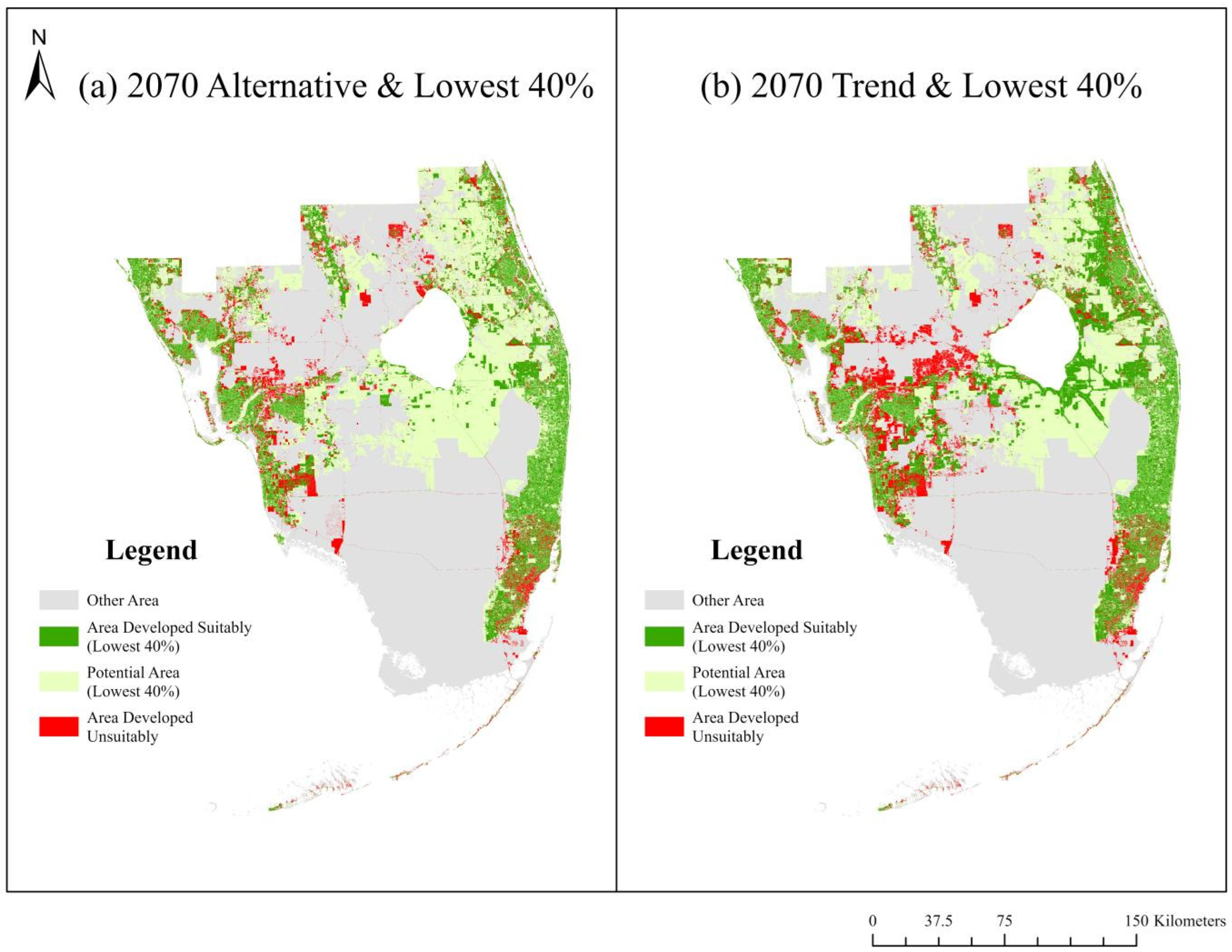
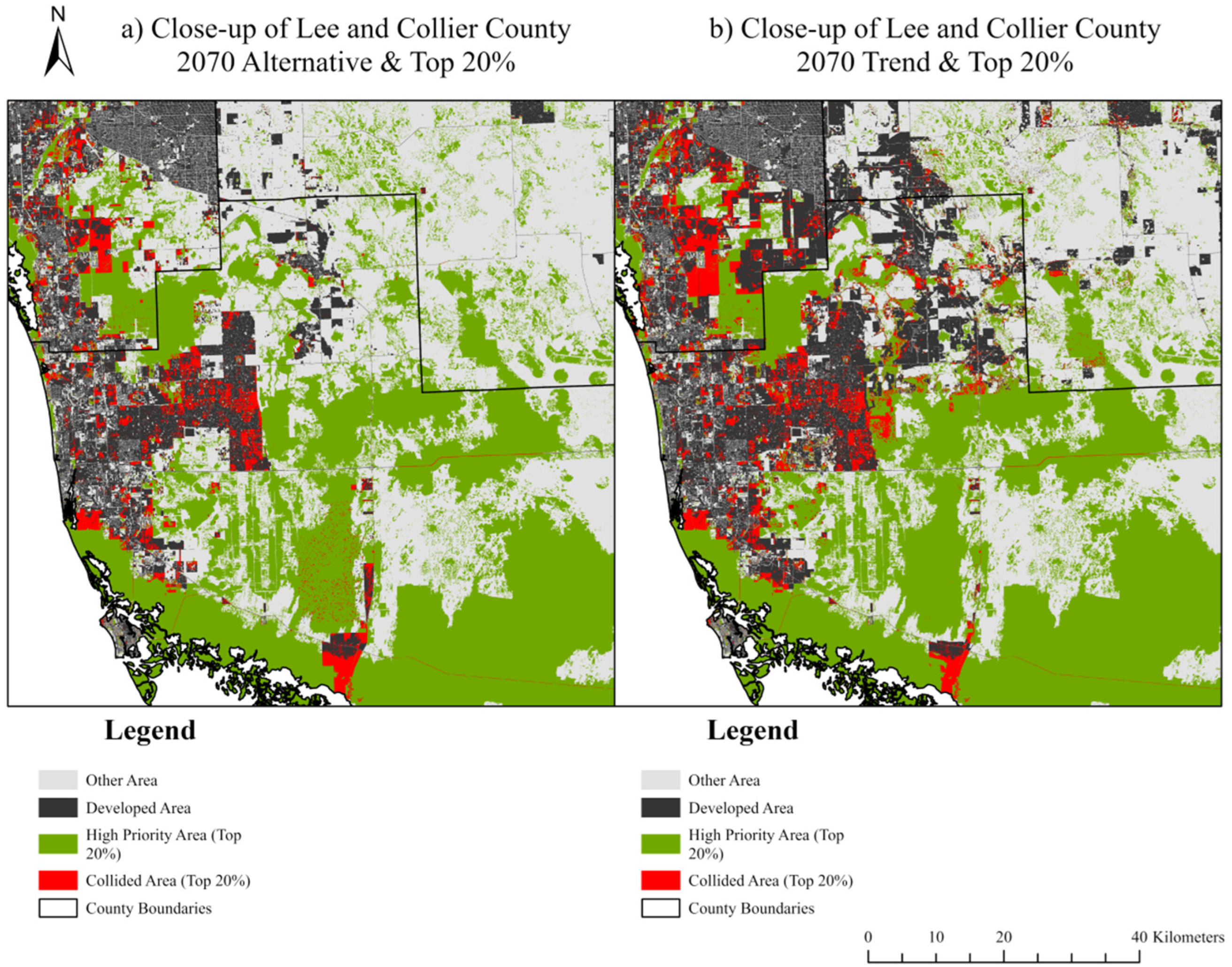
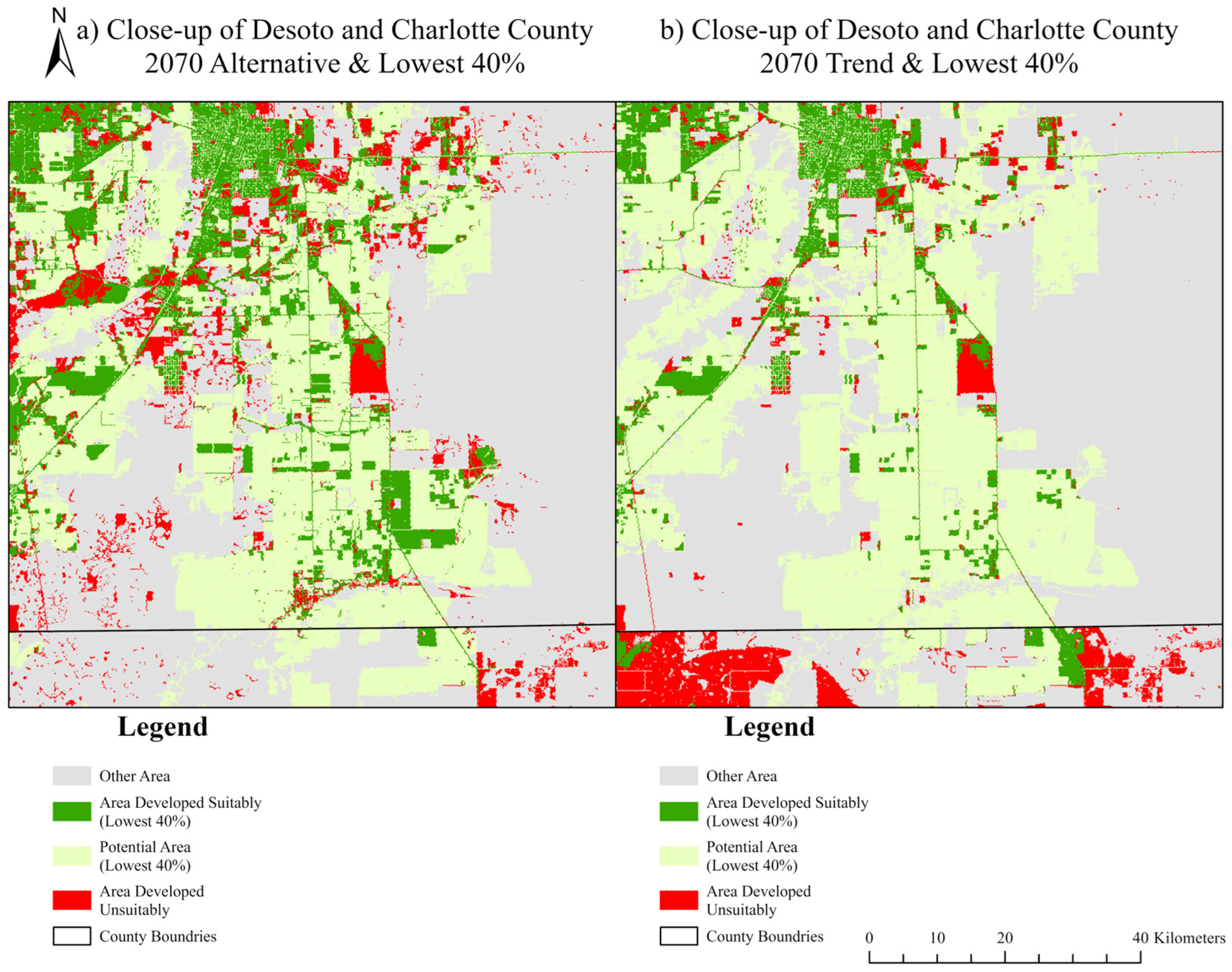
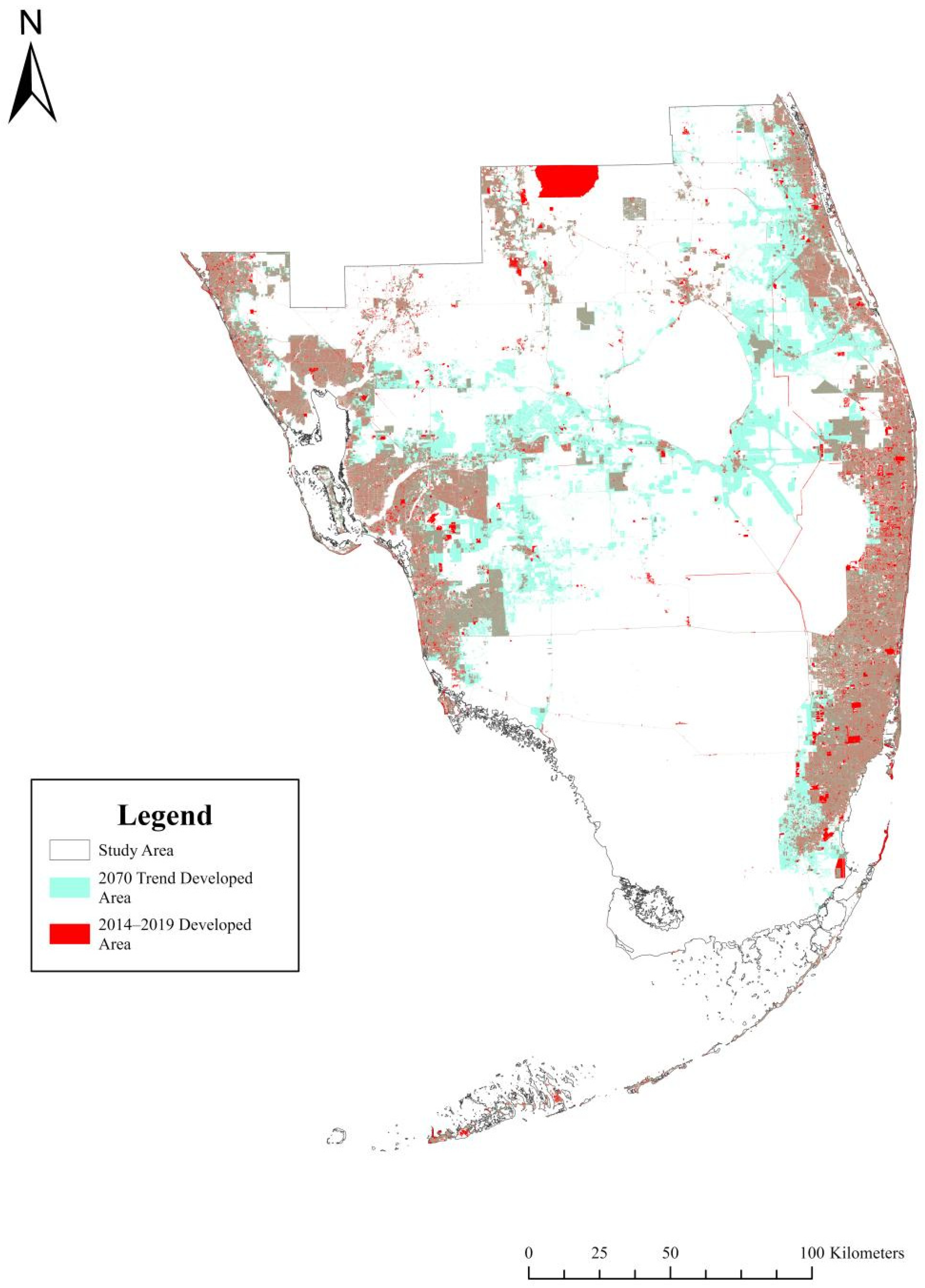
| Top 20% | Trend | Alternative | Proportion of Changes |
|---|---|---|---|
| Developed area (below top 20%) | 9318.3 km2 | 7143.8 km2 | −22.3% of Trend scenario |
| Collided developed area (top 20%) | 1169.9 km2 | 891.1 km2 | −23.8% of Trend scenario |
| High Priority Area (top 20%) | 7763.8 km2 | 8042.6 km2 | +3.6% of Trend scenario |
| Lowest 40% | Trend | Alternative | Proportion of Changes |
|---|---|---|---|
| Area developed unsuitably (above lowest 40%) | 3209.1 km2 | 2262.9 km2 | −29.5% of Trend scenario |
| Area developed suitably (lowest 40%) | 7279.1 km2 | 5772.0 km2 | −20.1% of Trend scenario |
| Potential area (lowest 40%) | 10,588.3 km2 | 12,095.4 km2 | +14.2% of Trend scenario |
| Developed Area | Area | Proportion of Changes |
|---|---|---|
| Baseline 2010 | 8482.3 km2 | Same |
| Current 2014–2019 | 13,698.0 km2 | +61.5% of Baseline 2010 |
| Trend 2070 | 11,735.0 km2 | +38.3% of Baseline 2010 |
Publisher’s Note: MDPI stays neutral with regard to jurisdictional claims in published maps and institutional affiliations. |
© 2022 by the authors. Licensee MDPI, Basel, Switzerland. This article is an open access article distributed under the terms and conditions of the Creative Commons Attribution (CC BY) license (https://creativecommons.org/licenses/by/4.0/).
Share and Cite
Lin, F.; Zhu, M.; Chen, F. Conservation and Development: Reassessing the Florida 2070 Planning Project with Spatial Conservation Prioritization. Land 2022, 11, 2182. https://doi.org/10.3390/land11122182
Lin F, Zhu M, Chen F. Conservation and Development: Reassessing the Florida 2070 Planning Project with Spatial Conservation Prioritization. Land. 2022; 11(12):2182. https://doi.org/10.3390/land11122182
Chicago/Turabian StyleLin, Fengze, Mingjian Zhu, and Fengming Chen. 2022. "Conservation and Development: Reassessing the Florida 2070 Planning Project with Spatial Conservation Prioritization" Land 11, no. 12: 2182. https://doi.org/10.3390/land11122182
APA StyleLin, F., Zhu, M., & Chen, F. (2022). Conservation and Development: Reassessing the Florida 2070 Planning Project with Spatial Conservation Prioritization. Land, 11(12), 2182. https://doi.org/10.3390/land11122182







